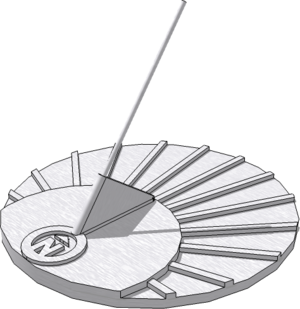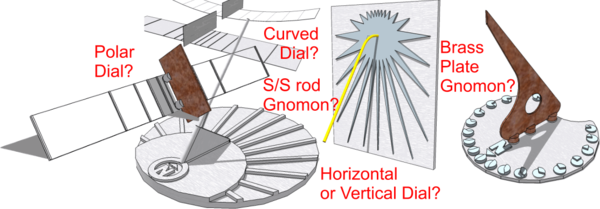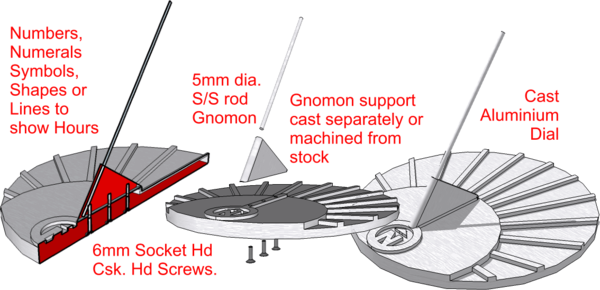Cast Aluminium Sundial: Difference between revisions
From DT Online
(Added Text) |
mNo edit summary |
||
| Line 10: | Line 10: | ||
=====Materials Available===== | =====Materials Available===== | ||
The main component ''(i.e. the 'Dial Plate')'' must be '''[[Cast Aluminium Plaquette|Sand Cast]]''' from aluminium using a one-piece pattern. Minor components may be added from any available material ''(e.g. stainless steel rod or brass plate for Gnomon, fixing screws, coloured polyester resign to fill recesses shaped to show numbers, numerals, symbols, shapes, lines etc.)''. | The main component ''(i.e. the 'Dial Plate')'' must be '''[[Cast Aluminium Plaquette|Sand Cast]]''' from aluminium using a one-piece pattern. Minor components may be added from any available material ''(e.g. stainless steel rod or brass plate for '''[[Sundials and Gnomons|Gnomon]]''', fixing screws, coloured polyester resign to fill recesses shaped to show numbers, numerals, symbols, shapes, lines etc.)''. | ||
| Line 41: | Line 41: | ||
* Use the '''DT Online''' '''[[Sundial Design Tools]]''' to work out the spacing or angles of your '''Hour LInes''' | * Use the '''DT Online''' '''[[Sundial Design Tools]]''' to work out the spacing or angles of your '''Hour LInes''' | ||
* Construct a full-size '''Pattern''' of your '''Dial Plate''' and '''Gnomon''' support using '''MDF''' or similar materials. | * Construct a full-size '''[[Sand Casting|Pattern]]''' of your '''[[Sundial Design Tools|Dial Plate]]''' and '''[[Sundials and Gnomons|Gnomon]]''' support using '''MDF''' or similar materials. | ||
* Any vertical sides should be given a slight taper to ensure the '''Pattern''' will withdraw from the mould. | * Any vertical sides should be given a slight taper to ensure the '''[[Sand Casting|Pattern]]''' will withdraw from the mould. | ||
* Ensure all inside corners are give a slight radius by using wood filler or painting with a good surface primer. | * Ensure all inside corners are give a slight radius by using wood filler or painting with a good surface primer. | ||
* Paint over to provide a good surface finish then follow the procedures for '''[[Sand Casting]]''' | * Paint over to provide a good surface finish then follow the procedures for '''[[Sand Casting]]''' | ||
* The '''Gnomon''' support may be a '''Split Pattern''' or cast using '''Odd- | * The '''Gnomon''' support may be a '''[[Sand Casting|Split Pattern]]''' or cast using '''[[Odd-side Moulding]]''' techniques. | ||
[[File:SundialProjectDevelopment.png|600px|center]] | [[File:SundialProjectDevelopment.png|600px|center]] | ||
* Remove the '''Sprues''' from the finished casting and machine surfaces where needed either with a '''[[Milling Machine]]''' or by '''Facing-off''' using a '''[[Centre Lathe]]''' with the casting fixed to a '''Face Plate'''. | * Remove the '''[[Sand Casting|Sprues]]''' from the finished casting and machine surfaces where needed either with a '''[[Milling Machine]]''' or by '''Facing-off''' using a '''[[Centre Lathe]]''' with the casting fixed to a '''Face Plate'''. | ||
* The casting may also be finished with '''[[Files and Rasps|Files]]''' and '''[[Emery Cloth]]''' or '''[[Wet or Dry Paper]]''' if machinery is not available. | * The casting may also be finished with '''[[Files and Rasps|Files]]''' and '''[[Emery Cloth]]''' or '''[[Wet or Dry Paper]]''' if machinery is not available. | ||
* Drill and '''[[Taps and Dies|Tap]]''' the '''Gnomon''' support to receive fixing '''[[Nuts, Bolts and Washers|Machine Screws]]''' and the threaded '''Gnomon''' rod. | * Drill and '''[[Taps and Dies|Tap]]''' the '''[[Sundials and Gnomons|Gnomon]]''' support to receive fixing '''[[Nuts, Bolts and Washers|Machine Screws]]''' and the threaded '''Gnomon''' rod. | ||
Latest revision as of 13:55, 26 December 2016
Design Brief
Design and make a Sundial to suit your home location Latitude which can be sited outside permanently in your community.
Materials Available
The main component (i.e. the 'Dial Plate') must be Sand Cast from aluminium using a one-piece pattern. Minor components may be added from any available material (e.g. stainless steel rod or brass plate for Gnomon, fixing screws, coloured polyester resign to fill recesses shaped to show numbers, numerals, symbols, shapes, lines etc.).
Considerations
- Where will the Sundial be located - (e.g. on a flat surface, a wall, a post, as part of another structure)?
- How can the Sundial be made weatherproof?
- Will it need to be vandal resistant?
- How accurate will it need to be?
- What limitations will Sand Casting impose on the design?
Research
- Which way should a Sundial face - does it matter?
- Why does Latitude of location matter?
- What types of Sundial are available?
- How are Sundials calibrated?
Ideas
- Find out about the various designs possible by Exploring Sundials in the DT Online Sundials section.
Design Development and Construction
- Use the DT Online Sundial Design Tools to work out the spacing or angles of your Hour LInes
- Construct a full-size Pattern of your Dial Plate and Gnomon support using MDF or similar materials.
- Any vertical sides should be given a slight taper to ensure the Pattern will withdraw from the mould.
- Ensure all inside corners are give a slight radius by using wood filler or painting with a good surface primer.
- Paint over to provide a good surface finish then follow the procedures for Sand Casting
- The Gnomon support may be a Split Pattern or cast using Odd-side Moulding techniques.
- Remove the Sprues from the finished casting and machine surfaces where needed either with a Milling Machine or by Facing-off using a Centre Lathe with the casting fixed to a Face Plate.
- The casting may also be finished with Files and Emery Cloth or Wet or Dry Paper if machinery is not available.
- Drill and Tap the Gnomon support to receive fixing Machine Screws and the threaded Gnomon rod.
Testing and Evaluation
- How accurate a timekeeper is it?
- Are members of your community pleased with it?
- Is it installed in the best place?
- Monitor over time and judge if it is affected by weather or vandalism.


